Conjoined twins are, even today, commonly referred
to as ‘Siamese Twins’, a term taken from the case of Chang and Eng Bunker, born
in Siam (now Thailand) on May 11th 1811. Their father was Chinese,
their mother was Chinese/Malay, and they were the fifth of their nine children.
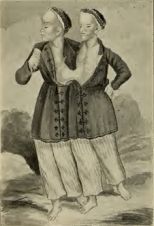 |
| Young Chang and Eng |
A cartilaginous band at the sternum joined the twins, with their livers fused
but independently complete. At birth, the shortness of the band forced them to
lie face to face, but over time, as they grew, the band stretched to about four
and a half inches in length, allowing them to stand side by side. In 1819,
their father died and Chang and Eng, even though only boys, became involved in
a series of business ventures, including a duck-rearing and preserved-egg farm.
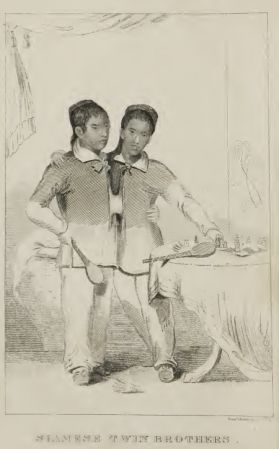 |
| The Siamese Twins |
In 1824, they were ‘discovered’ by a Scottish merchant, Robert Hunter, who saw
them boating, stripped to the waist and Hunter negotiated with their parents
and the King of Siam, Chowpahyi, to allow the boys to go with him on
exhibition. They left their duck-breeding concern in the care of a brother and,
on April 1st 1829, they departed for Boston, America on board the
ship Sachem, with Hunter and under the protection of its captain, Abel
Coffin. After a short stay in America, they sailed again, for England, on the
ship Robert Edwards, with Captain Sherburne.
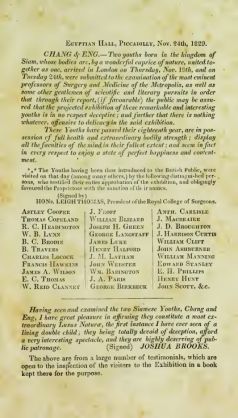 |
| Chang and Eng at the Egyptian Hall, Piccadilly, November 24th 1829 |
In London, they were
exhibited at the Egyptian Hall, Piccadilly, and then embarked on an extensive
tour of the cities and larger towns of Britain, and when they came of age in
May 1832, they undertook their own financial and touring arrangements (Hunter
and Coffin had fed very little of the income back to the boys).
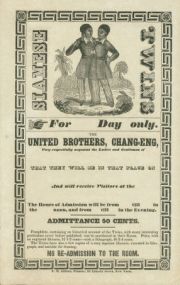 |
| Publicity Poster |
They returned
to the Americas in 1831, toured in the US, Canada and Cuba, before leaving
again for Europe, arriving in Paris in 1835 (although they were not welcome in
France, doctors feeling that any pregnant women who happened to see them may
have deformed children of their own, as a result of the maternal impression
formed), and also visiting Belgium and Holland, before returning again to
America a year later, where they grew tired of touring and settled down, became
naturalised citizens, invested their shared earnings and purchased a plantation
and slaves in North Carolina.
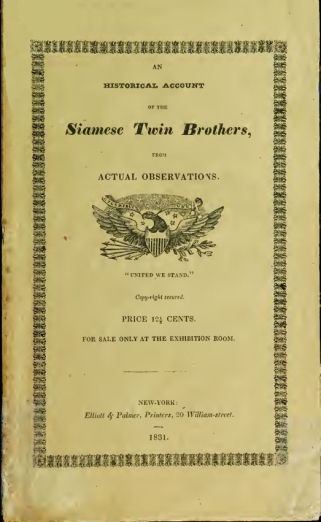 |
| The Siamese Twin Brothers - 1831 |
In respect for a woman who had treated them well
in New York, they assumed the surname Bunker, and on April 13th
1843, they married two sisters, Adelaide and Sarah, the daughters of a
neighbouring farmer and part-time preacher, David Yates.
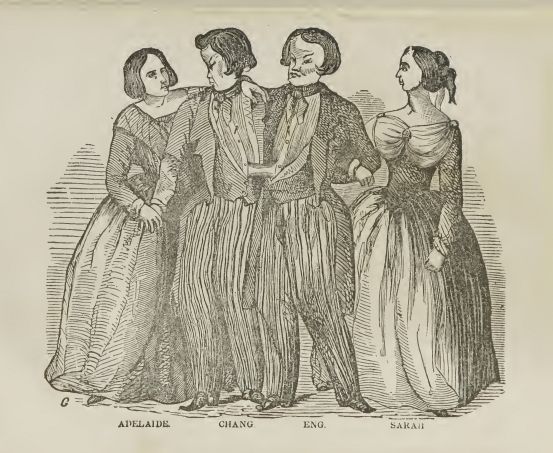 |
| Adelaide, Chang, Eng and Sarah |
Chang (pronounced Chun) always stood
on the left of his brother, he weighed 110 pounds and was five feet and one
inch tall. Eng (pronounced In) was five pounds heavier and one inch
taller; Chang wore blocks on the heels of his boots to lift him slightly. They
were able to run reasonably fast over short distances, could swim, and were
able to use farming implements with ease. They enjoyed hunting game, could read
and write tolerably well, played draughts and chess (although not against each
other) and adopted American dress, although they maintained the habit of
wearing their hair in long pigtails.
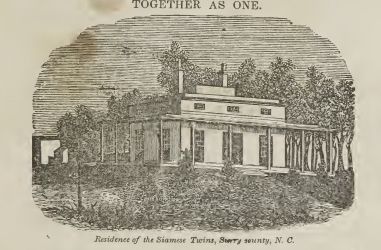 |
| Bunker Family Home, North Carolina |
In the early part of their married lives,
they shared a bed made for four, but when Adelaide and Sarah quarrelled, they
set up two separate households, a mile-and-a-half apart, spending three days a
week at each. Each was the master of his own home and his brother had to comply
totally with his wishes.
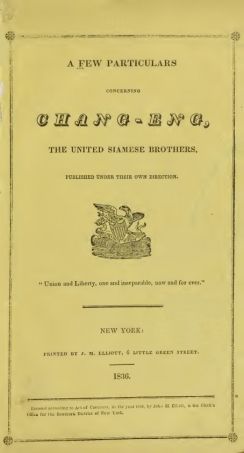 |
| Chang-Eng The United Siamese Brothers 1836 |
Chang and Adelaide had ten children, two of whom were
deaf-mutes, and Eng and Sarah had eleven children; one son of the former
couple, Christopher, and one son of the latter pair, Stephen, fought for the
Confederacy during the American Civil War.
 |
| Chang and Eng with sons |
As a result of that war, the Bunkers
lost some of their property, and began to exhibit themselves again, although
somewhat unsuccessfully. In 1869, they returned to Europe, ostensibly to seek
medical advice about the possibility of an operation to separate themselves,
following an acrimonious quarrel, although this was most likely a cover for
their renewing their touring careers in an attempt to recoup their post-war
financial losses.
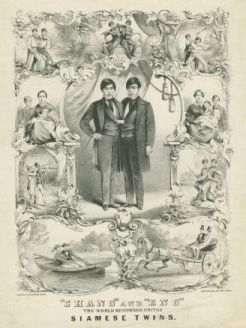 |
| The Siamese Twins |
As they grew older, Chang developed a taste for drink and was
frequently inebriated (although Eng remained sober when Chang was drunk), his
spinal curvature increased and he became hemiplegic on his right side. Both
brothers became partially blind in their anterior eyes, possibly as a result of
a lifetime of squinting outwardly and obliquely.
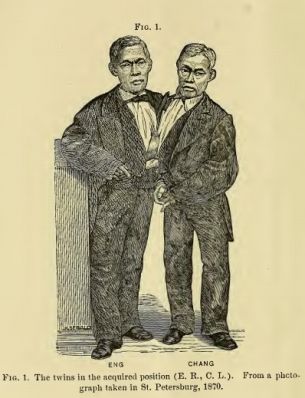 |
| Chang and Eng Bunker |
On Monday evening, January 12th
1874, Chang was seized with an attack of bronchitis whilst at his own home, but
by Wednesday, the symptoms had subsided a little and Eng insisted that they
should go to his house, as was their custom. On a freezing cold evening, and in
an open carriage, they rode the mile and a half to Eng’s home, where Chang
complained of chest pains and the inability to lie down in comfort. On the
Friday evening, they built a log fire and retired to bed, and the following
morning (Jan 17th), Eng called for his son, who slept in the room
above, to come and awaken Chang.
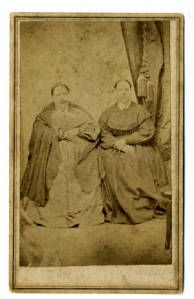 |
| Adelaide and Sarah in later life |
The boy came and announced, “Uncle Chang is
dead,” to which Eng responded with, “Then I am going.” He did not
refer to his brother again, other than to ask to be moved a little nearer to
him, but complained that he was choking and asked to be raised in bed. He
slowly lost consciousness and a little over two hours after Chang had died, his
brother Eng also died. The bodies were placed in a coffin, then in a tin box,
which was soldered shut, and the whole buried under charcoal in the cellar.
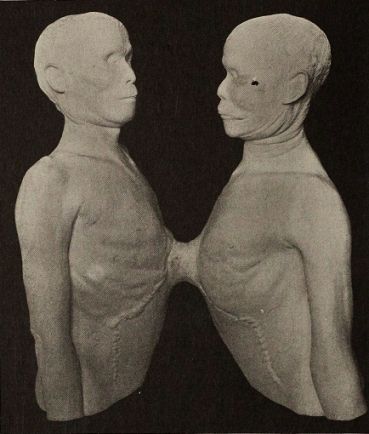 |
| Post-Mortem Cast of the Twins |
A
team of physicians made for Mount Airy, but did not arrive until a fortnight
later and, on Sunday February 1st 1874, fifteen days and eight hours
after their death, the coffin was exhumed and opened and the bodies injected
with zinc chloride, to begin the embalming process. The coffin and tin box were
then re-sealed and sent to the College of Physicians, Philadelphia, where a
detailed autopsy was carried out.
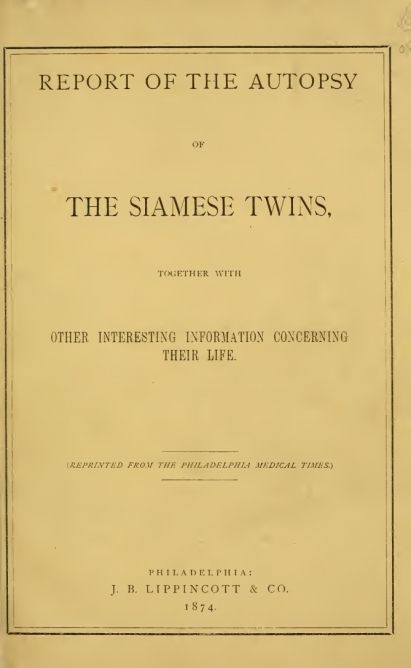 |
| Report of the Autopsy - 1874 |
Although, as I said at the very top,
conjoined twins are still referred to as Siamese Twins, although they were by
no means the originals.
No comments:
Post a Comment